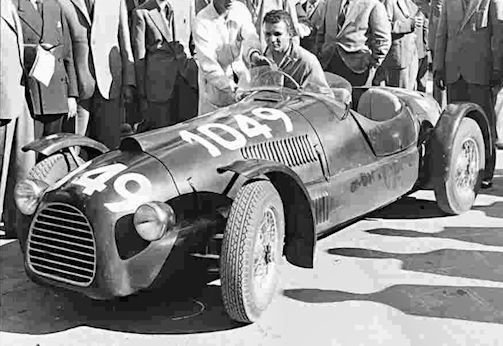Ferrari 166 SC
 |
|
|
Make |
Ferrari |
|
Class |
Race Car |
|
Category |
Sports Prototype |
|
Production |
1947 to 1948 |
|
Squad |
Scuderia Ferrari |
|
Built |
8 copies |
|
Chassis |
Steel tubular with spars and crosspieces. |
|
Motor |
Ferrari V12 front and longitudinal. |
|
Transmission |
Five-speed gearbox mounted together with the engine. Rear-wheel drive . |
The 166 SC is a racing car produced by Ferrari from 1947 to 1948 .
History
The competitive life of the 166 SC was fairly long as it raced throughout 1948 and 1949 in long and short wheelbase versions The Corsa version of the 166 equipped with the classic two-litre (1995.02 cc) engine had motorcycle-type mudguards, also called the Inter after the Besana brothers
The first example of this model built was actually the 159 S victorious at the 1947 Turin Grand Prix whose engine was replaced in December of the same year. The engine of the "166 SC" derived, indirectly, from the one installed on the first car to bear the Ferrari name , the 125 S. The aforementioned engine was a 1.5 L V12 , and was subsequently modified by increasing the displacement to just under 2 L by working on the stroke and bore . This evolution of the engine was then mounted on the “159 S” . However, the development of the engine did not stop here: the stroke and bore were slightly modified to obtain the "Type 166" engine, which had this name because 166 cm³ was its unit displacement , i.e. that relating to a single cylinder . The “Type 166” was then installed, this them gave its name, to the 166 SC Ferrari models, both single-seaters and two-seater sports prototypes . They shared the acronym “166” in the name and were the 166 F2 , the 166 FL , the 166 Inter , the 166 Inter Corsa , the 166 Inter Sport , the 166 MM and the 166 S. The model's abbreviation "SC" instead stood for "Spyder Corsa". After the example that derived directly from the 159 S, seven other 166 SCs were built in 1948 . These cars had the characteristic of having removable fenders and headlights , and this made them suitable for racing both in sports car races and in Formula 2 .
The model participated in both the Formula 2 championship and sports car competitions . Among the latter, the most important in which he took part were the 12 Hours of Paris , the Targa Florio and the Mille Miglia . In the 1948 edition of the latter, Tazio Nuvolari retired in Ospizio (Reggio Emilia) due to mechanical problems when he was leading the race: the driver first had the bonnet removed to remedy an imperfect closure, then a mudguard came off , subsequently the support of the mechanic's seat broke and finally, after too much of a slide, the support of a crossbow cracked . At this point Enzo Ferrari , given that Nuvolari had no intention of having a repair carried out so as not to lose the lead in the standings, ordered him to stop and retire.
Technical characteristics
The engine was a front and longitudinal non- supercharged V12 , the design of which was the work of Gioachino Colombo . The bore and stroke were 60 mm and 58.8 mm respectively , which brought the total displacement to 1995.02 cm³ . The block and the cylinder head were made of light alloy . The cooling system was water circulating . The compression ratio was 11:1, while the maximum power delivered by the engine was 130 HP at 6500 rpm .The distribution consisted of a single overhead camshaft which controlled two valves per cylinder . Power was provided by three Weber brand carburettors and model 32 DCF . The ignition was single and the relative system included two magnetos . The lubrication was wet sump , while the clutch was a dry single disc .
The front suspension was independent, with deformable wishbones and a transverse leaf spring , while the rear ones consisted of a rigid axle , longitudinal leaf springs and an anti-roll bar . Both had hydraulic shock absorbers . The brakes were drum brakes on the four wheels, while the steering was by worm screw and toothed sector. The traction was rear , and the transmission was made up of a five-speed manual gearbox plus reverse mounted in block with the engine .The chassis was tubular steel with side members and crosspieces, while the bodywork was a two-seater spider .The maximum speed reached by the 166 SC was 170 km/h .
In total eight examples were built.
PERFORMANCE
- Top speed 170 km/h
- Power to weight ratio 5.2 kg/hp
- Maximum power 130 hp at 6500rpm
- Specific power 65 hp / litre
Technical
-
Ferrari 166 SC Technical details and specifications (1947-1948)
ENGINE
Bore and Stroke 60x58.8 mm
Unitary cubic capacity 166.25
Total cubic capacity 1995.02
Valve gear single overhead camshaft
Number of valves two per cylinder
Compression ratio 11:1
Fuel feed Three Weber 32DCF carburettor
Ignition single, two distributors
Coolant water
Lubrication wet sumpTRANSMISSION
Rear-wheel drive
Clutch single dry disc
Gearbox five gears reverse en bloc with engineCHASSIS BODY:
Two-seater Roadster
longitudinal and cross membersSUSPENSION:
Front suspension
independent, double wishbones, transverse semi-elliptic spring hydraulic dampers
Rear suspension
live axle, longitudinal semi-elliphc springs, anti-roll bar, hydraulic dampersBRAKES:
drum
STEERING:
worm and sectorCAPACITIES:
Fuel tank 75lWHEELS TYRES:
Tyres front/rear 5.90-15 all roundDIMENSIONS AND WEIGHT
Wheelbase 2420 mm
Track front/rear 1270 / 1240 mm© Motor car History
